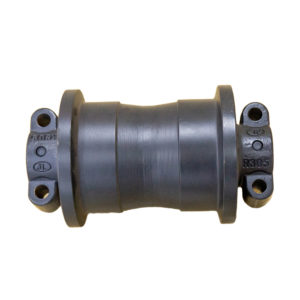During inspections of track rollers, it’s important to look out for signs of wear or damage that may indicate the need for maintenance or replacement.
Here are some common signs to watch for:
Excessive Wear: Inspect the surface of the track rollers for signs of excessive wear. Excessive wear may manifest as deep grooves, uneven wear patterns, or a significant reduction in the roller’s original diameter. Excessive wear can lead to reduced performance, misalignment, and increased stress on other undercarriage components.
Cracks or Breaks: Check for any cracks or breaks in the track rollers. Cracks can weaken the structural integrity of the rollers and may eventually lead to failure. Pay close attention to areas where stress is concentrated, such as around bolt holes or along the edges of the rollers.
Loose or Damaged Seals: The seals on the track rollers are designed to prevent contaminants from entering and to retain lubrication. Inspect the seals for any signs of damage, such as tears, cuts, or dislodgement. Damaged or loose seals can allow contaminants to enter the roller assembly, leading to increased wear and potential damage to internal components.
Abnormal Noise or Vibration: During operation, listen for any unusual noise or vibrations coming from the undercarriage. Excessive noise or vibrations may indicate worn or damaged track rollers. Pay attention to changes in noise or vibration levels compared to the machine’s normal operating conditions.
Misalignment or Uneven Track Tension: Inspect the alignment of the track rollers. Misaligned rollers can cause uneven track tension, resulting in increased wear on specific areas of the track and rollers. Look for any signs of misalignment, such as tracks that are visibly skewed or not properly seated on the rollers.
Excessive Play or Movement: Check for excessive play or movement in the track rollers. Excessive play can indicate worn bearings or other internal components. Excessive movement or play can lead to further wear and affect the stability and performance of the undercarriage.
Abnormal Track Wear: Inspect the condition of the track links and guide lugs. Excessive wear or damage to the track links and guide lugs can be an indication of issues with the track rollers. track with rollers Uneven wear patterns or excessive wear on specific areas of the track may suggest misalignment or damage to the rollers.
If any of these signs are observed during inspections, it is important to address them promptly. Depending on the severity of the wear or damage, maintenance or replacement of the track rollers may be necessary. Consult the excavator manufacturer’s guidelines and recommendations for proper maintenance procedures and contact a qualified technician or dealer for further assistance, if needed.
How can I find a qualified technician or dealer to assist with maintenance or replacement of track rollers?
Finding a qualified technician or dealer to assist with maintenance or replacement of track rollers for your excavator can be done through the following steps:
Consult the Manufacturer: Start by referring to the excavator manufacturer’s resources. They often have authorized service centers, dealerships, or a network of certified technicians who specialize in their equipment. Check the manufacturer’s website or contact their customer support for assistance in locating a qualified technician or dealer in your area.
Online Directories: Utilize online directories that specialize in connecting equipment owners with service providers. Websites like “Yellow Pages,” “Yelp,” or “Google Maps” allow you to search for local equipment service and repair businesses. Look for those with expertise in heavy machinery or specifically mention excavator maintenance and repair.
Recommendations and Referrals: Seek recommendations and referrals from other equipment owners, contractors, or industry professionals. They may have firsthand experience with reputable technicians or dealers who specialize in excavator maintenance. Ask for their recommendations and inquire about their satisfaction with the quality of service provided.
Equipment Rental Companies: Contact local equipment rental companies. They typically have service departments or work closely with service providers for maintenance and repair of their rental fleet. They might be able to provide you with recommendations or connect you with qualified technicians or dealers in your area.
Industry Associations: Reach out to industry associations or trade organizations related to construction, excavation, or heavy equipment. They often have directories or resources that can help you find certified technicians or dealers specializing in excavator maintenance. Examples of such associations include the Associated General Contractors (AGC) or the National Association of Heavy Equipment Training Schools (NAHETS).
Online Forums and Communities: Engage in online forums or communities dedicated to construction or equipment maintenance. Websites like “Heavy Equipment Forums” or “Contractor Talk” have active communities of professionals who can provide recommendations or share their experiences with equipment maintenance and repair service providers.
When you find potential technicians or dealers, it’s advisable to inquire about their qualifications, certifications, years of experience, and their familiarity with your excavator’s make and model. Additionally, consider factors such as their reputation, customer reviews, and overall professionalism before making a final decision.
Remember to communicate your specific needs regarding track roller maintenance or replacement and request cost estimates or quotes for the service before proceeding.
